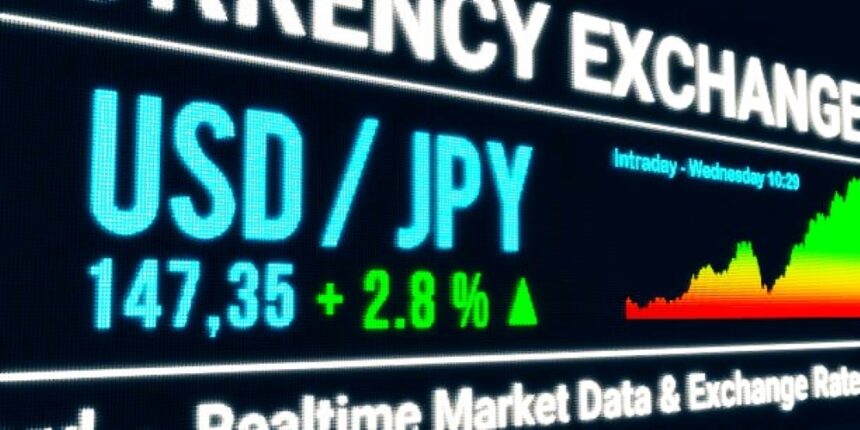The Japanese Yen (JPY) regained some lost ground during the Asian trading session on Thursday, clawing back from multi-month lows against the US Dollar (USD). This bounce comes on the back of stronger-than-expected macroeconomic data, with Japan’s Industrial Production rising by 1.7% in June, surprising markets and signaling resilience among manufacturers amid external headwinds.
In addition, Retail Sales climbed for the 39th straight month, showing a 2.0% year-on-year increase, slightly higher than the previous month’s 1.9% (revised) and above consensus forecasts. From a trader’s perspective, this reflects continued strength in consumer spending a positive indicator for internal demand stability and future inflation momentum.
Repositioning Ahead of the BoJ: Tactical, Not Transformative
As a financial market analyst with three years of forex trading experience, I see today’s price action as largely tactical repositioning. Many short-term traders are trimming USDJPY long positions in anticipation of the Bank of Japan’s policy announcement due later today. The BoJ expected to leave its short-term interest rates unchanged, but the focus will be on its quarterly economic outlook and Governor Kazuo Ueda’s commentary, which could shed light on the central bank’s rate trajectory through year-end.
Markets are still split on whether the BoJ will deliver another rate hike in 2025, especially after its historic exit from negative rates earlier this year. The latest data supports a hawkish tone, but lingering disinflationary signals and political uncertainty cast doubt on immediate tightening.
US-Japan Trade Deal: A Supportive Backdrop for BoJ?
Another underlying factor boosting the Japanese yen is the recently concluded US-Japan trade agreement, which many investors believe could lessen external risks for Japan’s export-heavy economy. A more stable trade environment, if sustained, would give the BoJ greater room to pursue gradual monetary tightening.
That said, global trade winds remain volatile, and Japan’s economy continues to face geopolitical supply-chain concerns, particularly in the semiconductor and energy sectors. This may temper optimism and restrict the BoJ from signaling anything too aggressive at today’s meeting.
Domestic Politics Throw a Wrench into BoJ Normalization
From a macro risk standpoint, Japan’s domestic political environment is becoming a growing concern. The ruling Liberal Democratic Party (LDP) suffered unexpected losses in the July 20 local elections, which could embolden opposition parties pushing for more fiscal stimulus and tax cuts.
This could delay Japan’s path toward fiscal consolidation and complicate the BoJ’s normalization narrative. A more populist fiscal stance might force the BoJ to remain cautious, especially if it risks undermining the inflation targets the bank has only recently begun to consistently meet.
As someone who’s actively tracked BoJ policy shifts for three years, I find that political noise often translates into policy delays especially when the BoJ is navigating a tightrope between inflation control and growth support.
USD Still Holding Strong: Fed Keeps Pressure on the Yen
While the Japanese yen enjoys a momentary bounce, the broader USD trend remains supportive due to hawkish Federal Reserve signals and a solid string of US economic releases.
On Wednesday, the Fed held its benchmark interest rate steady but the FOMC vote was split, with two dissenting members pushing for a hike. This was the first such split since 1993, and it reinforces the view that rate cuts are not imminent.
Fed Chair Jerome Powell added fuel to the fire by stating that it’s “too soon” to consider a rate cut in September, further strengthening the USD across the board. The ADP private payroll report also impressed, showing a 104K job gain in July, rebounding from June’s weakness.
Moreover, the US GDP grew at an annualized pace of 3.0% in Q2, reversing the prior quarter’s contraction. This supports the Fed’s stance that the US economy remains robust and capable of weathering “modestly restrictive” policy for longer.
All Eyes on US PCE Inflation Data
As traders brace for the BoJ press conference, attention will soon shift to the US Core PCE Price Index, the Fed’s preferred inflation gauge, due later in the day. A higher-than-expected print will likely reignite US Dollar bullish momentum, potentially reversing the JPY’s current gains.
Conversely, a soft reading might weaken Fed tightening expectations and offer fresh tailwinds for USD/JPY bears. In either case, volatility is expected to spike later in the North American session.
USDJPY Technical Outlook: Caution Ahead of Event Risk
From a technical analysis standpoint, USDJPY remains trapped in a short-term consolidation range after hitting its highest level since April. The pair saw stiff resistance near 148.85, while support seen around 147.20, followed by a more solid base near the 100-day EMA around 146.30.
Momentum indicators on the 4H chart show mild bearish divergence, while RSI retreats from overbought territory. This supports the view that short-term pullbacks are likely, but medium-term trends remain USD-supportive especially if the Fed remains on hold and BoJ signals caution.
My 3-Year Market Perspective: Don’t Underestimate Policy Divergence
Over the last three years, the key dynamic in the USDJPY pair has been central bank policy divergence. The Fed’s assertive tightening and the BoJ’s ultra-loose policy stance created a one-way trend for much of 2022-2023. Even now, despite the BoJ’s normalization start, the interest rate gap remains wide, and that alone will continue to support the USD unless Japan drastically shifts gears.
Today’s recovery in the JPY feels more like a pause than a pivot. The underlying structural drivers policy divergence, capital outflows, and Japan’s demographic/fiscal constraints—are still intact. Traders should treat this JPY strength as tactically driven and remain cautious about over-committing to bearish USD/JPY positions unless the BoJ or US data genuinely surprise.
Conclusion: The Japanese Yen Rises, but Uncertainty Lingers
The Japanese Yen’s bounce reflects a temporary reprieve fueled by strong domestic data and pre-BoJ repositioning. However, the path ahead remains uncertain.
Will BoJ Governor Ueda hint at a hike before year-end?
Can the BoJ tighten without derailing Japan’s fragile recovery?
Will the Fed continue to delay cuts as US growth persists?
These unanswered questions will keep the USDJPY pair in focus through the remainder of the week.
Disclaimer: This blog is for informational purposes only and does not constitute financial advice. Always conduct your own research and consult a professional advisor before making investment decisions.
[sc_fs_multi_faq headline-0=”h2″ question-0=”Why did the Japanese Yen rebound today?” answer-0=”The rebound was triggered by stronger-than-expected Japanese economic data (Retail Sales and Industrial Production) and some profit-taking ahead of the BoJ’s policy decision.” image-0=”” headline-1=”h2″ question-1=”Will the Bank of Japan raise rates today?” answer-1=”Most analysts expect the BoJ to leave rates unchanged, but the focus will be on Governor Ueda’s comments about potential hikes later this year. ” image-1=”” headline-2=”h2″ question-2=”What does the US-Japan trade deal mean for the Yen?” answer-2=”It could reduce trade-related uncertainty for Japan’s exporters, allowing the BoJ more confidence in future tightening.” image-2=”” count=”3″ html=”true” css_class=””]









